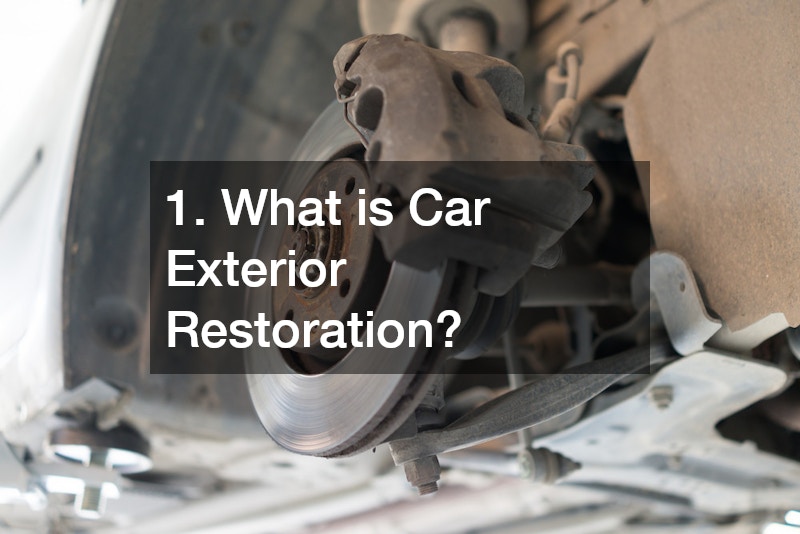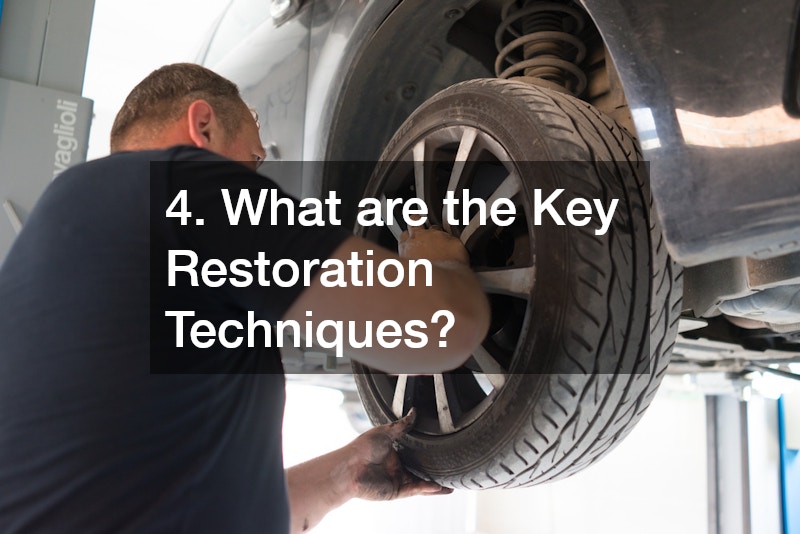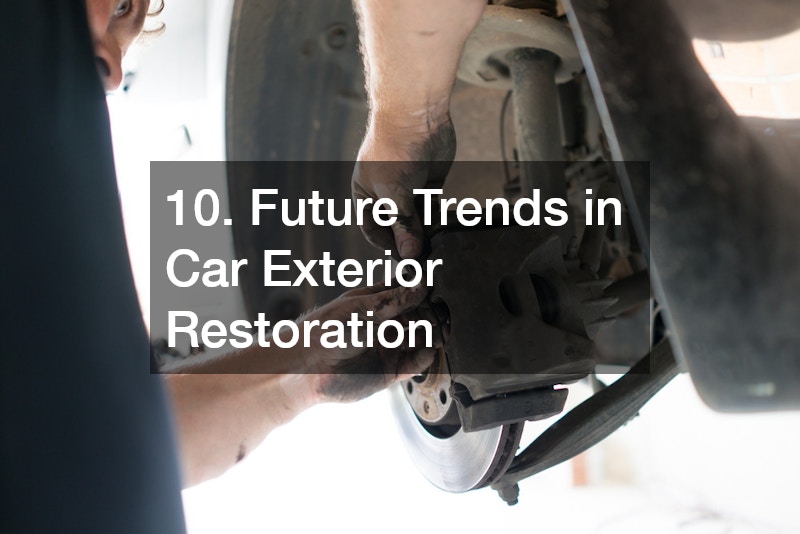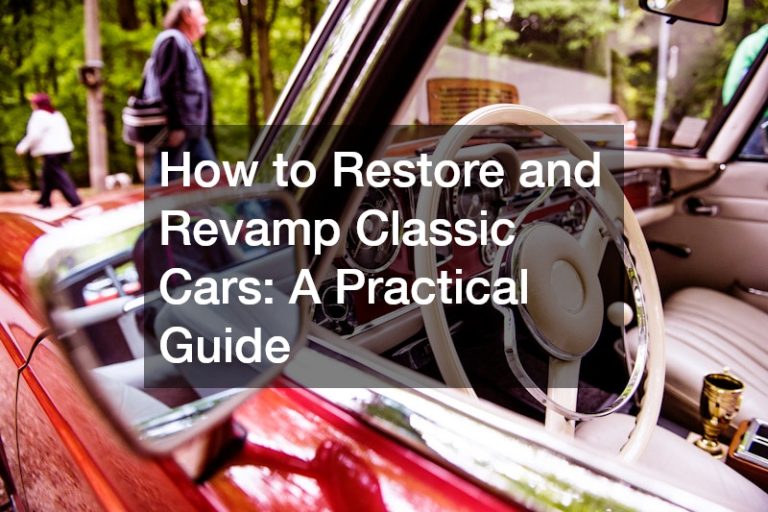
In the dynamic world of automotive ownership, car exterior restoration emerges as a pivotal process for those purchasing used vehicles. This transformative endeavor encompasses a variety of techniques aimed at enhancing both the aesthetic appeal and market value of a pre-owned car. Whether purchased from a dealer or through a private sale, nearly every used car can benefit from some level of restoration. New owners stand to gain not just a visually pleasing vehicle but one that’s mechanically sound and environmentally friendly. As the introduction opens a doorway into the subsequent sections, it becomes apparent that car exterior restoration is not just an option but a necessity for maximizing the value and satisfaction derived from a used car.
1. What is Car Exterior Restoration?

Car exterior restoration refers to the comprehensive suite of techniques employed to refurbish the outer shell of a vehicle. This involves processes that can range from detailed cleaning and waxing to extensive auto body repairs. Car exterior restoration aims to address all visual and structural imperfections that can detract from the appearance and functionality of a vehicle. By focusing on the exterior, this approach ensures that the car not only looks good but is also protected against the elements.
Part of the restoration process includes the replacement of critical components, such as timing belt replacement. A well-maintained timing belt is essential for the engine’s proper functioning, which in turn affects overall vehicle performance. Including such mechanical updates as part of car exterior restoration ensures that the car runs smoothly, complementing its refreshed exterior with reliable performance.
In many cases, car exterior restoration will also involve enhancements like remote start installation. This feature adds a modern touch to older cars, significantly improving user convenience. Ultimately, restoration is not just about fixing what’s broken; it’s about bringing a used vehicle into a new era of reliability and enjoyment, offering owners a car that they can genuinely take pride in.
2. Why is Car Exterior Restoration Important?
Car exterior restoration is critical for preserving and enhancing the value of a used vehicle. A well-maintained exterior is a key selling point that can significantly boost a car’s resale value. Potential buyers are more likely to pay top dollar for a car that looks new and runs well, thanks to thoughtful restoration efforts. The visual impact of a restored car can be a decisive factor for a buyer weighing options in a competitive market.
The importance of restoration goes beyond mere monetary value; it also plays a crucial role in safety and functionality. For instance, installing a remote start can add a layer of comfort and security, allowing owners to start their cars from a distance in adverse weather conditions. This feature is a testament to how restoration can blend convenience with modern-day necessities, enriching the overall driving experience.
Furthermore, car exterior restoration instills a sense of pride and satisfaction in owners. Driving a well-maintained vehicle can boost confidence and make daily commutes or long drives more enjoyable. In essence, restoration is a process that not only revives a car but also renews the emotional connection between the owner and their vehicle, fostering a lasting partnership built on trust and reliability.
3. How to Assess the Need for Restoration?
Assessing the need for car exterior restoration begins with a thorough visual inspection of the vehicle. Look for obvious signs of wear and tear, such as scratches, dents, and fading paint, which can all serve as indicators that restoration is needed. A detailed examination allows owners to identify specific areas that require attention, ensuring a comprehensive and targeted restoration effort.
Consultation with professionals at a local auto body shop can provide further insights into the restoration needs. These experts can offer a detailed diagnosis of the car’s condition, outlining necessary repairs and enhancements to ensure the vehicle is in optimal shape. Their expertise can guide the restoration process, making certain all aspects of the car’s exterior are addressed efficiently.
Additionally, potential issues in the car’s exterior and mechanical components can often be linked. For example, if a vehicle shows signs of misalignment, it may indicate a need for adjustments along with potential mechanical repairs such as brake repair. Coalescing auto body insights with mechanical evaluations offers a holistic view, ensuring that both appearance and performance are optimized through restoration.
4. What are the Key Restoration Techniques?

Car exterior restoration is a multi-faceted process, involving several key techniques to revitalize a used vehicle. One of the most common techniques is auto body repairs, which address dents, scratches, and other imperfections that degrade the car’s appearance. Skilled professionals can effectively restore the body’s original form, ensuring a smooth and flawless surface that resonates with a brand-new look.
Repainting is another crucial technique that involves matching the car’s color precisely, achieving a uniform finish that enhances its visual appeal. This process not only makes the car look aesthetically pleasing but also protects it from environmental damage. Properly applied paint acts as a shield, guarding the metalwork against rust, UV rays, and other harmful elements.
Detailing plays a pivotal role in car exterior restoration, focusing on areas that require thorough cleaning and polishing. From the exterior body to intricate components like headlights and tail lights, detailing ensures that every element shines under scrutiny. This meticulous approach is vital for achieving the sense of newness that owners desire when investing in restoration efforts.
5. How Much Does Car Exterior Restoration Cost?
The cost of car exterior restoration can vary significantly depending on the extent of work required and the specific needs of the vehicle. Basic restoration tasks like minor paint jobs and dent removal can run from a few hundred to a few thousand dollars. The financial commitment depends largely on the car’s condition and the desired level of restoration.
More extensive restoration efforts, including full-body repairs and repainting, will naturally incur higher costs. Such comprehensive projects might range from several thousand to upwards of ten thousand dollars, especially when adding extra features like new car tires or specialized detailing. Investing in quality restoration, however, often yields a substantial ROI through increased vehicle value and owner satisfaction.
Mechanical aspects, such as brake repair, might also be incorporated into the overall cost if they complement the exterior restoration efforts. Pricing varies between DIY approaches and professional services, but skilled labor at a trusted local auto body shop ensures an optimal outcome for those willing to invest. Carefully budgeting and understanding the cost factors involved ensures that car owners can make informed decisions, aligning finances with restoration goals.
6. DIY Restoration vs. Professional Services
Choosing between DIY restoration and professional services is an important decision for anyone embarking on car exterior restoration. DIY approaches can be cost-effective, especially for minor touch-ups and simple cleaning tasks. With proper knowledge and the right tools, owners can handle some aspects of restoration personally, gaining both hands-on experience and a fulfilling sense of achievement.
However, more complex tasks often necessitate professional services, as they require specialized skills and equipment not typically accessible to average car owners. Professionals can ensure that every detail is handled with precision, from paint matching to intricate bodywork. Their expertise not only minimizes the risk of error but also guarantees a superior finish that is difficult to replicate on one’s own.
While DIY can be a tempting option, especially for minor restoration tasks, hiring a professional service offers peace of mind and saves valuable time. Particularly for major restorations and mechanical updates like new car tires or transmission repair service, relying on expert hands generally leads to more satisfactory and durable results. Balancing financial constraints with desired outcomes often helps in deciding which approach best suits individual restoration needs.
7. What are the Environmental Benefits?

Car exterior restoration presents several environmental benefits, aligning well with sustainable practices. By opting for restoration, owners extend the vehicle’s lifespan, reducing the need for new car production. This contributes to conserving resources, minimizing the environmental impact associated with manufacturing and disposing of vehicles.
Properly maintained vehicles consume fuel more efficiently, as issues like aerodynamic drag due to damaged exteriors are minimized. This efficient operation reduces greenhouse gas emissions and results in an overall positive impact on the environment. Car exterior restoration ensures that vehicles remain eco-friendly by maintaining their operational efficiency over time.
Integrating environmentally-conscious practices during restoration, such as using eco-friendly cleaning products and recycling materials, further enhances the green aspect of restoration efforts. Professional services, in particular, are often equipped to incorporate such practices, supporting both environmental sustainability and outstanding restoration results. Engaging in restoration is a step towards responsible ownership, balancing personal benefits with ecological considerations.
8. Case Studies of Successful Restorations
Examining case studies of successful car exterior restorations sheds light on the profound impact that thoughtful restoration can achieve. One notable example is of a classic car enthusiast who transformed an aged vehicle into a showstopper, leveraging expert auto body repairs. This revival not only won awards at local auto shows but significantly increased the car’s market value.
Another case study highlights a regular commuter car brought to life through the installation of contemporary features during restoration, such as a remote start installation. These upgrades, coupled with meticulous detailing, resulted in a modern, stylish vehicle that retained its vintage charm. The balance of old and new elements showcased the versatility and potential of car exterior restoration.
Professional restoration services were pivotal in these transformations, underlining the value of expertise and precision in achieving stellar results. These stories illustrate the endless possibilities unlocked by dedicated restoration efforts, proving that even the most forlorn vehicles can be revitalized into valuable assets with the right combination of techniques and talent. Such successes stand as a testament to the potential of car exterior restoration in redefining a vehicle’s future.
9. Common Challenges in Car Exterior Restoration
Car exterior restoration is not without its challenges, as various factors can complicate the process. One common issue is accurately matching paint colors, particularly for older vehicles with faded or custom paint jobs. This requires skilled professionals equipped with high-quality products to ensure a seamless integration with existing paintwork.
Addressing structural damage hidden beneath cosmetic issues is another challenge that often arises in restoration. Damage may necessitate extensive auto body repairs and could call for additional expertise, such as that of a diesel truck mechanic, to address the more technical aspects. Identifying these hidden issues early in the process ensures that restoration is comprehensive, leaving no stone unturned.
Managing costs while maintaining quality is yet another difficulty faced by car owners. Balancing budget constraints with the desire for a thorough and professional restoration can be tricky, often requiring prioritization of repairs. Selecting reliable local auto repairs can alleviate some of these concerns, providing quality assurance that aligns with financial and aesthetic goals.
10. Future Trends in Car Exterior Restoration

The future of car exterior restoration is shaped by advanced technologies and evolving customer expectations. Innovations such as 3D printing and high-tech materials are revolutionizing auto body repairs, offering more efficient and durable solutions. These futuristic developments stand to make restoration faster and more accessible, opening new doors for both professionals and DIY enthusiasts.
Moreover, the rise of the ” cash for cars” industry presents an opportunity for restoration to play a part in the automotive recycling process. By restoring viable vehicles for resale or recycling their parts, the restoration industry can contribute to reducing waste, exemplifying the dual role of restoration in prolonging vehicle life and promoting sustainable automotive cycles. As these trends unfold, the future of car exterior restoration looks bright and promising, ready to adapt and innovate.
Car exterior restoration offers an array of benefits that extend beyond aesthetic appeal. It rejuvenates used vehicles, elevating their market value while addressing both visual and mechanical concerns. By investing in restoration, car owners not only enhance their driving experience but also participate in practices that support sustainability and environmental responsibility.
By examining the various aspects of restoration, from techniques to potential challenges, it becomes evident that this is a vital process for any used car owner. Future trends suggest a drive towards more innovative and eco-friendly methodologies, ensuring that restoration remains a relevant and beneficial practice for generations to come. Car exterior restoration is more than just a cosmetic fix; it is a celebration of automotive resilience and a step towards sustainable driving pleasure.




